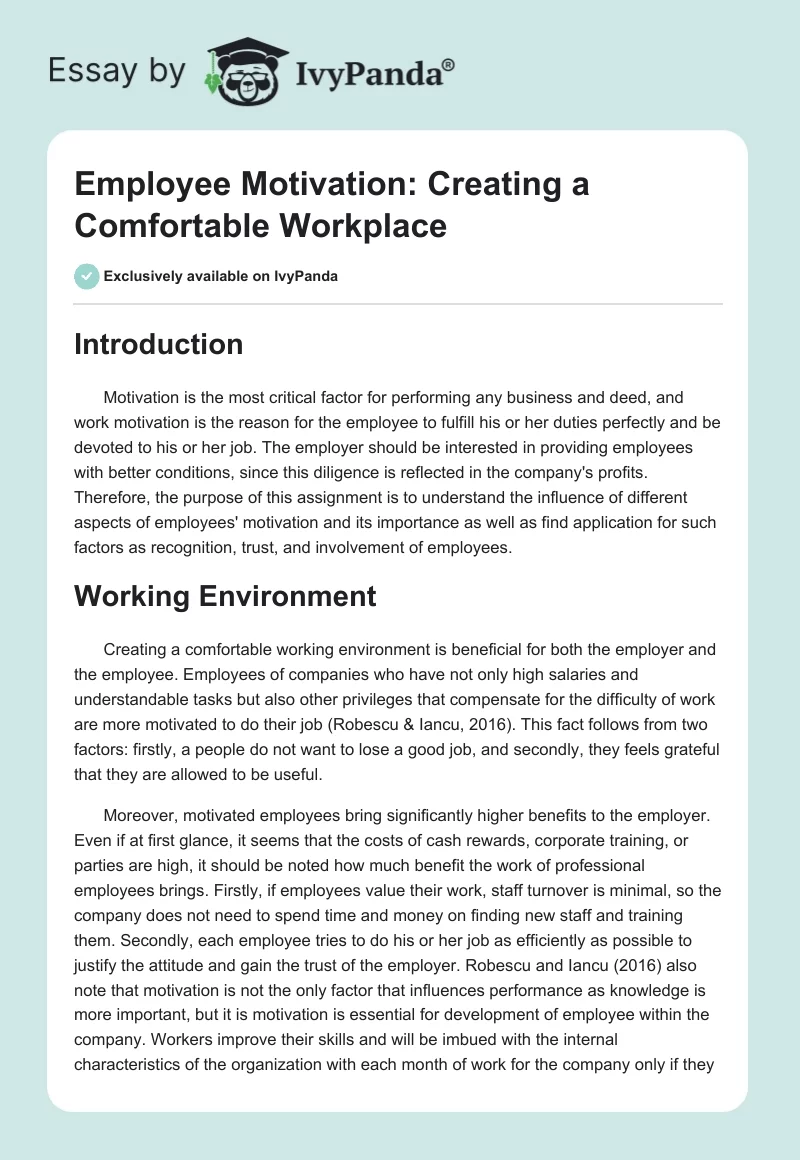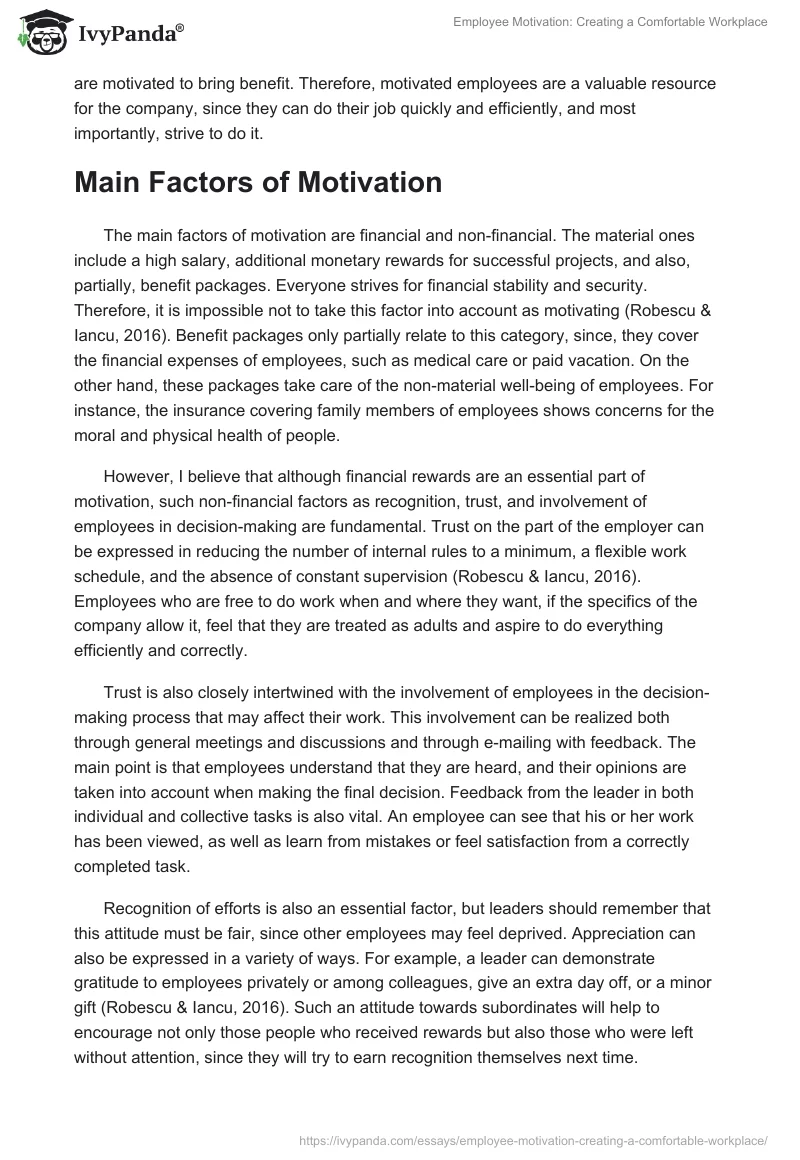Introduction
Motivation is the most critical factor for performing any business and deed, and work motivation is the reason for the employee to fulfill his or her duties perfectly and be devoted to his or her job. The employer should be interested in providing employees with better conditions, since this diligence is reflected in the company’s profits. Therefore, the purpose of this assignment is to understand the influence of different aspects of employees’ motivation and its importance as well as find application for such factors as recognition, trust, and involvement of employees.
Working Environment
Creating a comfortable working environment is beneficial for both the employer and the employee. Employees of companies who have not only high salaries and understandable tasks but also other privileges that compensate for the difficulty of work are more motivated to do their job (Robescu & Iancu, 2016). This fact follows from two factors: firstly, a people do not want to lose a good job, and secondly, they feels grateful that they are allowed to be useful.
Moreover, motivated employees bring significantly higher benefits to the employer. Even if at first glance, it seems that the costs of cash rewards, corporate training, or parties are high, it should be noted how much benefit the work of professional employees brings. Firstly, if employees value their work, staff turnover is minimal, so the company does not need to spend time and money on finding new staff and training them. Secondly, each employee tries to do his or her job as efficiently as possible to justify the attitude and gain the trust of the employer. Robescu and Iancu (2016) also note that motivation is not the only factor that influences performance as knowledge is more important, but it is motivation is essential for development of employee within the company. Workers improve their skills and will be imbued with the internal characteristics of the organization with each month of work for the company only if they are motivated to bring benefit. Therefore, motivated employees are a valuable resource for the company, since they can do their job quickly and efficiently, and most importantly, strive to do it.
Main Factors of Motivation
The main factors of motivation are financial and non-financial. The material ones include a high salary, additional monetary rewards for successful projects, and also, partially, benefit packages. Everyone strives for financial stability and security. Therefore, it is impossible not to take this factor into account as motivating (Robescu & Iancu, 2016). Benefit packages only partially relate to this category, since, they cover the financial expenses of employees, such as medical care or paid vacation. On the other hand, these packages take care of the non-material well-being of employees. For instance, the insurance covering family members of employees shows concerns for the moral and physical health of people.
However, I believe that although financial rewards are an essential part of motivation, such non-financial factors as recognition, trust, and involvement of employees in decision-making are fundamental. Trust on the part of the employer can be expressed in reducing the number of internal rules to a minimum, a flexible work schedule, and the absence of constant supervision (Robescu & Iancu, 2016). Employees who are free to do work when and where they want, if the specifics of the company allow it, feel that they are treated as adults and aspire to do everything efficiently and correctly.
Trust is also closely intertwined with the involvement of employees in the decision-making process that may affect their work. This involvement can be realized both through general meetings and discussions and through e-mailing with feedback. The main point is that employees understand that they are heard, and their opinions are taken into account when making the final decision. Feedback from the leader in both individual and collective tasks is also vital. An employee can see that his or her work has been viewed, as well as learn from mistakes or feel satisfaction from a correctly completed task.
Recognition of efforts is also an essential factor, but leaders should remember that this attitude must be fair, since other employees may feel deprived. Appreciation can also be expressed in a variety of ways. For example, a leader can demonstrate gratitude to employees privately or among colleagues, give an extra day off, or a minor gift (Robescu & Iancu, 2016). Such an attitude towards subordinates will help to encourage not only those people who received rewards but also those who were left without attention, since they will try to earn recognition themselves next time.
Therefore, I believe that I can motivate employees by combining all of these approaches. Recognition can be expressed with half-monetary rewards; for example, the best employee may get paid vacation in another city or country. However, praise should also be used by the leader to encourage other successful employees. Trust can be demonstrated by a flexible work schedule, although the deadlines must remain clear. It is best to provide everyone with an opportunity to express their idea about important issues, and give feedback on it to involve workers in decision-making.
Conclusion
In conclusion, the financial and non-financial motivation of employees is the most critical factor for them and the benefit of the company, and both methods have to be used. Motivated employees want to bring all their knowledge to develop the company and make it more successful. This fact also gives positive changes and financial benefits to the company, which has professional workers and does not spend money on training new employees.
Reference
Robescu, O., & Iancu, A.-G. (2016). The effects of motivation on employees performance in organizations. Valahian Journal of Economic Studies, 7(2), 49–56.


